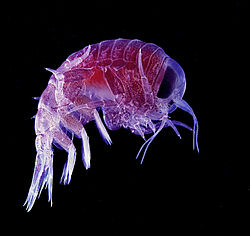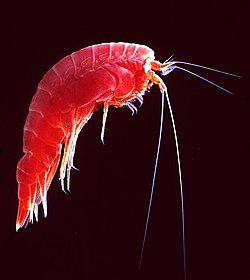Amphipoda: Difference between revisions
m even better then |
limnic of course (doh) |
||
| Line 20: | Line 20: | ||
'''Amphipoda''' (amphipods) is an order of animals that includes over 7000 described [[species]] of small, [[shrimp]]-like [[crustacean]]s. |
'''Amphipoda''' (amphipods) is an order of animals that includes over 7000 described [[species]] of small, [[shrimp]]-like [[crustacean]]s. |
||
Most amphipods are [[marine (ocean)|marine]]; a few are [[fresh water| |
Most amphipods are [[marine (ocean)|marine]]; a few are [[fresh water|limnic]] or [[terrestrial animal|terrestrial]]. Marine amphipods may be [[pelagic]] (living in the water column) or [[benthic]] (living on the ocean bottom). Pelagic amphipods are eaten by [[seabird]]s, fish, and marine mammals. Terrestrial amphipods such as [[sand flea]]s can often be seen amongst sand and pebbles or on beaches. |
||
==Distribution and life== |
==Distribution and life== |
||
Revision as of 13:57, 4 March 2007
| Amphipoda | |
|---|---|

| |
| A hyperiid amphipod (Hyperia macrocephala) | |
| Scientific classification | |
| Kingdom: | |
| Phylum: | |
| Subphylum: | |
| Class: | |
| Order: | Amphipoda Latreille, 1816
|
| Sub-orders | |
Amphipoda (amphipods) is an order of animals that includes over 7000 described species of small, shrimp-like crustaceans.
Most amphipods are marine; a few are limnic or terrestrial. Marine amphipods may be pelagic (living in the water column) or benthic (living on the ocean bottom). Pelagic amphipods are eaten by seabirds, fish, and marine mammals. Terrestrial amphipods such as sand fleas can often be seen amongst sand and pebbles or on beaches.
Distribution and life
Many species of pelagic amphipods are mutualistic or (usually) parasitic, living in association with jellyfish and salps. Phronima is a relatively common genus of pelagic amphipod that kills and cleans out the barrel-shaped body of a salp to live inside and raise its young.
Of the relatively few species of free-living, planktonic amphipods, the most abundant of all is Themisto gaudichaudii. Living in the Southern Ocean, this amphipod congregates in dense swarms, where it is a voracious predator of copepods and other small members of the zooplankton.
After copepods, krill and salps, which are mostly herbivorous, the carnivorous Themisto is the most abundant member of the mesozooplankton in the Southern Ocean.
In cold seas, benthic amphipods are enormously diverse and abundant. In the Southern Ocean, amphipods are the most abundant benthic crustaceans. Some are grazers, many are omnivorous, some even act as piranha-like scavengers, quickly cleaning the carcasses of dead animals. Amphipods are one of the few animal groups frequently seen when submarines venture to the deepest parts of the oceans. Other benthic amphipods are the primary food of Gray Whales.
A fouling species of amphipod common to Atlantic and estuarine waters is Jassa falcata.
Trivia
Gammaracanthuskytodermogammarus loricatobaicalensis has been claimed as the longest binomial name. It was proposed by B. Dybowski for an amphipod from Lake Baikal; it was later invalidated by the ICZN.
External links
- Amphipoda page at www.crustacea.net includes a list of families
- The Amphipod Home Page
- A database of amphipod literature

